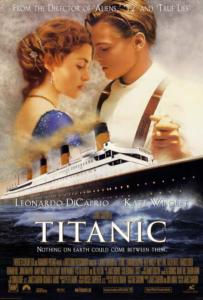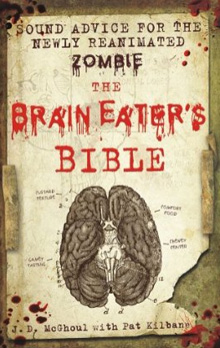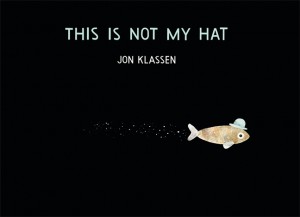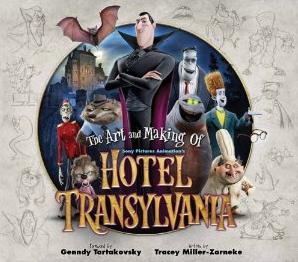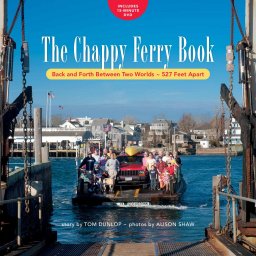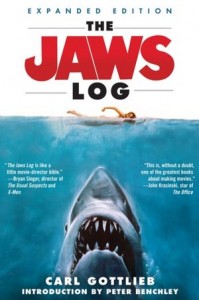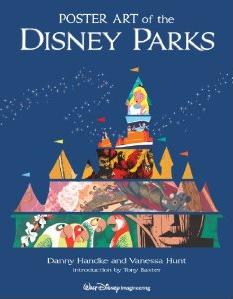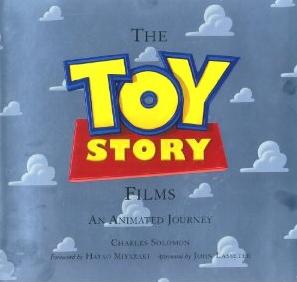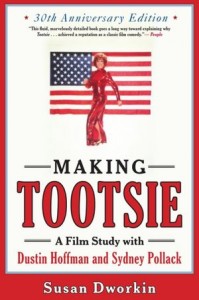A couple of years ago, on my 50th birthday, one of my best “Jaws” buddies presented me with a photograph from “Jaws 2” autographed by one of the film’s then-teenage stars, Tom Dunlop. Less then a year later I had the great opportunity to meet Mr. Dunlop while on a visit to Martha’s Vineyard, where he lives. In our brief conversation I learned that he had followed his love for writing into adulthood and had written a couple of books related to the Vineyard and was finishing up a third. This summer I visited the island again and picked up his latest book, an in depth and entertaining look at the Chappy Ferry, the barge/boat combination that takes pretty much anything you could imagine the short distance from Edgartown to the small island of Chappaquiddick. While celebrating the release of the book Mr. Dunlop took the time to chat with Media Mikes about acting (he’s Julliard trained), the island he loves and how piloting the Ferry isn’t as easy as it looks.
Mike Smith: You originally began a career as an actor — what made you pursue writing?
Tom Dunlop: In a way, I began doing both at about the same time, but writing actually came first.
As a summer kid on Martha’s Vineyard in the early 1970s, I took an interest in the Vineyard Gazette, the weekly paper not far from my home in Edgartown, and when I was fourteen I got my first summer job cleaning up the back shop after printing days. I made five bucks a week! I told Dick and Jody Reston, the publishers, that I liked reading newspapers – the Gazette especially – and wanted to learn how to write for it. They started giving me press releases to re-write and actual stories to cover. I got my first front page by-line in the Gazette when I was fifteen. It was a story about the Edgartown Regatta. Never in my life had I known a thrill like holding a paper with my story on the front page, and my name at the start!
Though I wanted to act very much, I only started performing in plays during my sophomore year in high school, because the schools I went to before that had almost nothing in the way of drama programs. My father was an English teacher at a boarding school in northern Virginia, and every six weeks or so the whole student body would travel by bus into Washington, D.C. to see plays at Arena Stage and what is now known as the Shakespeare Theater. My mom, dad, and I went on these theater trips too, and I fell in love with those great city theaters. Everything I did in school after that – and I was fortunate to go to some very good schools: Taft, Brown, the Juilliard Drama Division – was meant to prepare me to be a member of an acting company like Arena’s.
“JAWS 2” was something of a detour. I just lucked into that part. Though I was at Taft, my home was now Edgartown, and as school was coming to an end that spring, the “JAWS 2” company was looking for a kid who could sail an old-fashioned sailboat called a Herreshoff 12½. My stepfather owned the first H-12½ in the harbor. So I’d had some practice sailing it, and convinced Shari Rhodes (the casting director) and Dorothy Tristan (the screenwriter at that point) that I was the only kid in town who knew the boat well enough to do the job. It wasn’t true, but I was a good enough actor to convince them! As much of an adventure as shooting that movie was, it didn’t dissuade me from wanting to act full time on stage. So that’s what I studied and trained for, and those were the sorts of acting jobs I pursued for about twelve years after graduating from Juilliard in 1988. I loved the theater work when I landed it. But while I was preparing for a life in a repertory company, going from play to play to play within one theater, the theaters themselves were disbanding their companies, hiring actors only on an as-needed bases. Under those circumstances, I never worked as consistently as I wanted or needed to.
So it was a really lucky break that I never lost my love for journalism, because when I decided to close out my acting career in 2000, all sorts of new opportunities were waiting for me on the Vineyard: the managing editorship – and briefly the editorship – of Martha’s Vineyard Magazine, feature stories to write for the paper and the magazine – and now, incredibly, books about the most amazing businesses on Martha’s Vineyard!
MS: What was it about the Chappy ferry that made you want to write about it?
TD: I fell for the Chappy ferry when I was four years old. On a stormy June day, my parents took me down to see it, and I remember rounding the corner on Dock Street and seeing this matchbox sized ferry – the original ON TIME – shoveling its way across the harbor entrance, white water spraying over its deck. (NOTE: Fans of the film “Jaws” will recognize the ON TIME as the ferry on which Brody is browbeaten into keeping the beaches open for the Fourth of July) You know how some people fixate on rockets when they first see them? Or muscle cars? Or thrillers about a shark menacing an island off the coast of southern New England? Right there and then, I fixated on the Chappy ferry pretty much like that.
To me, it’s an utterly unique enterprise – more than two hundred years old as a service, yet doing pretty much exactly the same thing it was doing the first time a guy rowed some other guy across the harbor for a penny or two. That sense of a history living on into my own time thrills me completely. I also admire the seamanship of the captains and deckhands, who drive these things at right angles to all the traffic they encounter at one of the narrowest, busiest, and most tide swept places in the whole harbor. You just can’t believe some of the weather they sail through, especially in the winter. Imagine a blizzard. And imagine that ferry sailing through it all day or all night. Because that’s what it does, almost no matter the weather. It takes a huge, truly dangerous storm to stop the ferry from running.
Most of all, though, I wanted to write about it because I knew from a very young age, exploring the files at the Vineyard Gazette and the Martha’s Vineyard Museum, that no one had ever told the whole story before. The fact that I’d get to be the very first guy to do that for a ferry I adore simply blew me away. I often say I’m the luckiest writer on Martha’s Vineyard for the stories I’ve gotten to tell. But sometimes I think I’m the luckiest writer anywhere.
MS: This is your third book centered around/on Martha’s Vineyard. What is it about the island that inspires you?
TD: A wonderful question!
Some of it is obvious. If you watch “JAWS,” and if you’ve visited it before, you know that nothing else looks quite like it. Not even Nantucket or Cape Cod, which are both right next door. There’s a powdery quality to the light that softens and deepens everything it touches on the Vineyard, a phenomenon I notice every day. Even when it’s stormy, or brisk and cold, there’s something about the light over the Island that I’ve never seen anywhere else.
I love the history of the Vineyard. Outside of a city like Boston or New York, you’d be very hard to find anyplace else in the continental United States with an older or better-documented history than Martha’s Vineyard. The white men and women who settled this place in 1642 were compulsive record keepers and historians; they wrote down everything — in letters, journals, whaling logs, deeds, wills, club minutes, store ledgers, diaries, weather records, newspapers. You get to see the history of this place from all these parallax views, so that it feels as alive and present-day as any history can possibly be.
Finally the answer comes down to the stories I’ve gotten to tell. If you look at the book I wrote with photographer Alison Shaw about Morning Glory Farm, or the one about the building of the schooner REBECCA at the Gannon and Benjamin wooden-boat building yard in Vineyard Haven, or the new ferry book, you come to the very quick and certain conclusion that there’s no place on earth quite like this one. There’s no other place with a collection of businesses quite like these, which – to the people who run them – amount to causes. These are callings that most people would never feel, let alone dream up, establish, invest in and run with everything they’ve got, unless they realized that they were already fortunate enough to live in the only place on earth that could welcome and support them all.
MS: Have you ever had the opportunity to pilot the Ferry?
TD: Another great question!
Yes. Three or four times with an increasingly cocky belief that nothing could be easier. And then, just once, with such incompetence and fright that I vowed never to try it again. Some years ago, I wrote a feature story about the ferry for Martha’s Vineyard Magazine…in fact, the idea to write a book came from reporting and writing that story in 2007. The editor of the magazine, Nicki Miller, and the art director, Alley Moore, challenged me to try skippering the ferry myself, and we ran that story as a sidebar headlined “How Hard Could It Be?”
The captains were very kind to let me try it. It was winter, so we held off until those crossings when there were no other passengers or cars aboard and no other boats sailing into or out of the harbor. I stood up on the platform at the helm, the console right in front of me, looked left and right, saw no traffic, and pushed the throttle down. The ferry left the Chappy slip smoothly and growled her way reliably across the channel toward Edgartown. The only trick to it, really, is that there is a toggle rather than a steering wheel. You goose it left or right to turn the boat. And though the toggle snaps back to an upright position when you let it go, the rudder below you stays where you angled it. So the ferry keeps turning until you toggle the rudder back to center.
I confess this took a little getting used to. The first time, approaching the Edgartown slip, I noticed the bow swinging off to one side at the last minute, and though I reversed hard, I pretty much T-boned the end of the bulkhead on the right side as you face the ramp. But even though the slip appears to get narrower and narrower as you glide toward it, I began to get a feel for it. As I say, on my third or fourth crossing, I was sure I had the whole thing down. Really… How Hard Could It Be?
Until. . . .
Until one windy night at the end of April of that year, after a storm tore through South Beach at the far end of the harbor, opening it to the Atlantic. It was the first time I tried driving the ferry at night, and the first time I’d attempted to drive it in the ferocious, tsunami-like currents that had begun rolling through the harbor entrance as a result of the second, new opening to the ocean.
The captain let me take her out of the Chappy slip and the second we got into the channel, I felt the tide bang into the hull, almost like we’d hit a wall. Leaving the slip, I had a good sense of what the lights looked like over on the Edgartown side, and thus what to aim for. But as I gunned the engine and looked ahead, I realized that those weren’t the lights I was seeing, because the tide had pushed the bow of the ferry almost 45 degrees to the right, toward the Harbor View Hotel.
Further off to my right, I caught a glimpse of the flashing Edgartown lighthouse – that couldn’t possibly be right! The ferry never pointed in that direction except in “JAWS: THE REVENGE,” and we know how that turned out. I felt a wave of fear rise up – where were we exactly? What was I pointing at? I had millions of dollars of ferryboat beneath my feet. Was I about to hit something? I’d lost my bearings, and in my confusion, I pushed the toggle in the wrong direction. Instead of swinging back in the right direction, we kept turning . To make a very long story short, had you been standing on the upper deck of Memorial Wharf that windy night, looking across to Chappy, what you would have seen was the ferry leaving the Chappy slip, sailing properly toward you for perhaps three seconds, and then veering away toward the lighthouse. And then continuing to turn. Inexplicably, you’d have seen the ferry make a complete circle in the middle of the harbor entrance before finally putting her nose back in the general direction of the Edgartown slip. And finding her way there, against all odds.
I say with the deepest gratitude imaginable that Maddie LeCoq, the captain at the time, took over and put the ferry in the slip for me. Had she not assumed command, the headline would have read something like this: AMITY KID WRECKS CHAPPY FERRY / WELDON BOY “NOT GOOD ENOUGH” RIGHT TO THE VERY END. (NOTE: while some of you are reading this headline and scratching your head, fans of “Jaws 2” are giggling uncontrollably. “Weldon” was Dunlop’s character’s last name in the film).
MS: What are you working on now?
TD: Peter Wells, co-owner of the ferry with his wife Sally Snipes, wants to build a third ferry so that he always has at least two in the water, ready to work at a moment’s notice, all year-round. Peter is a far-sighted, environmentally conscious guy, and it’s his ambition to build and run the third ferry on an electric motor only. This would be a huge development in the world of commercial boating – very few operators have dared to make that leap. If Peter does this, John Wilson, who produced “THE CHAPPY FERRY MOVIE,” a wonderful short film of the ferry that comes with the book on DVD, wants to make a documentary about the building and launching and operation of this new ferry. And I want to help him do it. We think such a film would go a long way to showing how far electric motors have come, and how reliably clean, efficient, and durable they can be, even when put to the test that the ferry would surely give them.
Also, for the Vineyard Gazette, John and I are working on another project, whereby we’re finding old movies of the Vineyard – mostly home movies, but some commercial ones too – and converting them to digital files. We’re going to tell the stories of what these movies show of the old Vineyard, show clips from them on the new Gazette web site, and begin to create an archive so that these irreplaceable films are not lost to neglect or ignorance.
If the above interview has whetted your appetite for the magic of Martha’s Vineyard, Media Mikes recommends the following books written by Tom Dunlp and featuring illustrative photographs by Alison Shaw:
· MORNING GLORY FARM AND THE FAMILY THAT FEEDS AN ISLAND (Vineyard Stories, 2009)
· SCHOONER: BUILDING A WOODEN BOAT ON MARTHA’S VINEYARD (Vineyard Stories, 2010)
· THE CHAPPY FERRY BOOK: BACK AND FORTH BETWEEN TWO WORLDS – 527 FEET APART (VineyardStories, 2012)
They are available at www.VineyardStories.com, your local book store and Amazon.com
Related Content
